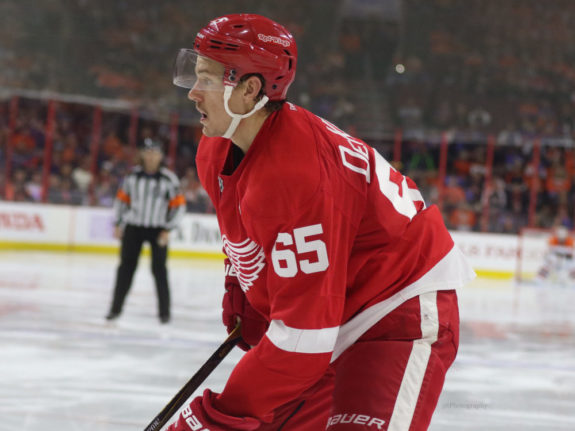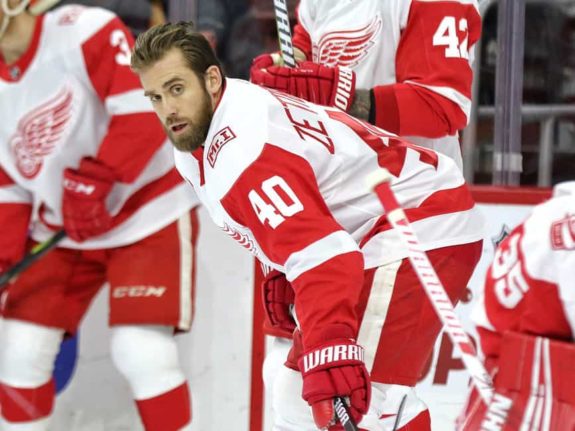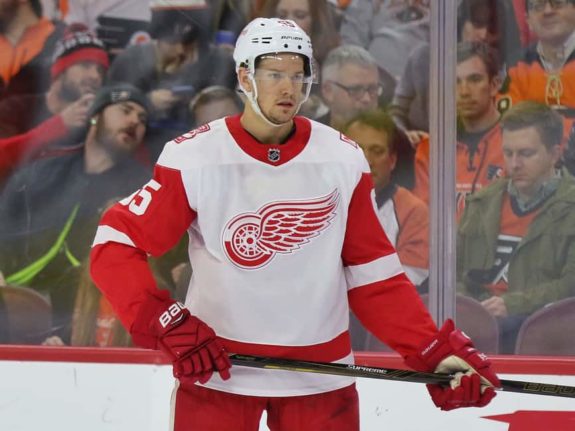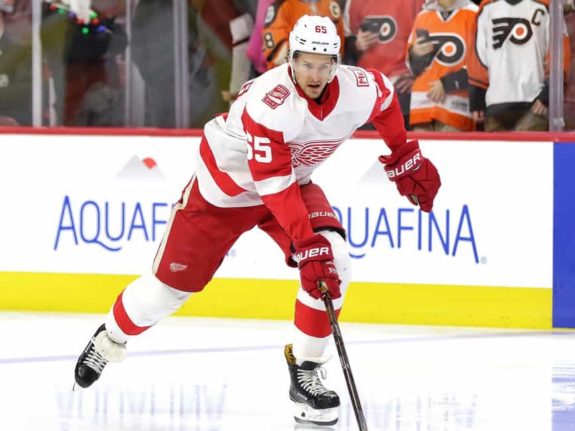Hockey players and athletes all over the world are a prideful bunch. They are constantly betting on themselves no matter the circumstances. Losses sting like an ugly break-up. Listening to criticism is like pouring gasoline on an open fire. Obstacles and setbacks, no matter how big they are, look more like detours to them than stop signs. It’s why we always hear about players playing through the most mind-boggling injuries during the playoffs, and sometimes even during the regular season. While a common cold can pin the best of us to our couches, these individuals can look at an x-ray of a broken bone and ask “can I still play on it?”
But sometimes, even as hard as they try, injuries succeed in exposing their mortality. It’s in those moments that we can watch a player from our TV screens and think “man, this guy has really lost a step.” If you can see it, they can feel it.
Perhaps the latest shocking development from the Detroit Red Wings this season was that veteran defenseman Danny DeKeyser was placed on waivers on February 14. The following day, it was confirmed that he had not been claimed, and the Red Wings sent him to the team’s taxi squad.
How does a team’s longest-tenured defenseman find himself off the roster and among the team’s reserves? Well, it helps to add a bit of context to what DeKeyser has been through over the last year or so.
The Surgery
Following an eight-game stint to begin the 2019-20 season where he collected four points, DeKeyser came out of the lineup due to back pain. He eventually had to undergo surgery in December of 2019, thus ending his season just as it began. It was a shame not just for the Red Wings, but for a player that looked arguably the best on the ice that he had in a couple years.
After a couple of middling seasons from 2016 to 2018, he had finally regained his form during the 2018-19 season, and he was set to log big minutes on the team’s top defensive pairing alongside then-22-year-old Filip Hronek. The injury and eventual surgery stopped any momentum the defenseman had dead in its tracks.
““He’s our top defenseman and I think he’s a super-underrated player in the league. He’s one of the better defenders in the league, one of the better guys at moving a puck,” Red Wings head coach Jeff Blashill said at the time.
Ansar Khan of MLive spoke with the defenseman himself for an article about the recovery process that was published in May of last year. Through quotes from DeKeyser, it was revealed that the back injury was one that seemed to have built up over time.
“They said sometimes when you injure a disc you feel it right away or sometimes it just kind of builds up over time,” DeKeyser said. “Maybe there was an injury a year or two ago and it just kind of slowly built up.”

After the rest of the Red Wings’ 2019-20 season was effectively cancelled in March due to COVID-19, DeKeyser was able to spend more time at home working out, rehabbing the muscles in his back and hanging out with his wife and two daughters, McKinley and Claire – the latter of which was born last April while the NHL season was suspended. While that quality time was surely appreciated by both him and his wife Melissa, there was no doubt that he was eager to return to the ice.
“I’m itching to get back out there,” DeKeyser said. “I just want to play again.” (From “Red Wings’ Danny DeKeyser recovering from back surgery, eager to return” – MLive.com – 5/5/20)
A Role Model to Look Up to
When DeKeyser, who hails from a Detroit suburb, joined the team during the 2012-13 season as a college free agent out of Western Michigan University, he received a phone call from team captain Henrik Zetterberg, welcoming him to the Red Wings organization. That was Zetterberg’s 10th season with the Red Wings, and his first season as captain. Up to that point, “Hank” had only played a full 82-game season once in his career, but his health was rarely put under the microscope. He was arguably both the Red Wings’ best player and their most important.
And yet, just a little under a year later during the 2014 Sochi Olympics, Zetterberg found himself immobilized by pain that drew the sympathies of his Swedish teammates, as well as Slovakian defenseman Zdeno Chara who carried his bags for him upon his arrival back in the United States.
“He couldn’t lie down. He couldn’t sit up. He couldn’t sleep. If he dozed off, it was only momentarily. Teammates would come visit and it was hard for them to even look at him. He had conversations he doesn’t remember having, erased by the pain.” The Athletic’s Craig Custance wrote about Zetterberg’s Olympic experience. “This lasted three days. He was sustained mostly by Strawberry McFlurries. (Gustav) Nyquist would get texts from Zetterberg asking him to pick up two McFlurries from the McDonald’s in the athlete dining hall. One he’d eat right away. The other, he’d put in the freezer for later.” (From “Henrik Zetterberg: Leaving a lasting impact on the franchise” – The Athletic – 12/18/17)

Zetterberg could have called it quits following those Olympics and nobody would have blamed him. He had a Gold Medal from the 2006 games in Torino, Italy. He won the Stanley Cup with the Red Wings in 2008 and was awarded the Conn Smythe Trophy as the playoff MVP. He succeeded Nicklas Lidstrom as team captain. He was getting ready to start a family with his wife, Emma. What could possibly convince this man to return to the ice given his condition?
Remember, those athletes are a prideful bunch.
Miraculously, following a surgery in February of that year, Zetterberg was able to return for two playoff games that season, recording two points in the process. He followed that up by returning to the team for the 2014-15 season, in which he won the King Clancy Memorial Trophy for his leadership on and off the ice. From that season until the final game of his career, he missed just five games, collecting 240 points through those 323 games.
Throughout Zetterberg’s heroic display to cap off his career, DeKeyser was there watching.
Teammates Help Teammates
DeKeyser’s situation is not a mirror image of Zetterberg’s, despite their similarities. No. 40 was lucky enough to get into some game action during the 2014 playoffs, and then take the offseason to get back to full-health, or as close to it as he could get. No. 65 had to sit idle for well over a year due to circumstances outside of his control. For a defenseman whose greatest tool has almost always been his mobility, that much down time is going to cause some problems.

Furthermore, to put it quite bluntly: Zetterberg at 80% was still a lot better than most players at 100%; DeKeyser at 80% (or wherever he’s at right now) puts him on the fringe of the lineup. As important as “DK” is to the Red Wings’ lineup, that distinction is contingent upon him performing at the level he was at prior to the surgery. Detroit didn’t send him to the taxi squad to punish him, they did it to give him the time he needs to get his feet back and rediscover his game.
As great as Zetterberg was during those final four seasons, you could tell that he wasn’t the same version of himself that once killed off a five-on-three in the Stanley Cup Final almost by himself. He was never the most mobile forward, but his skating stride seemed to lose a step in those final years. He excelled by using his mind and skill, not his necessarily his body. If DeKeyser’s issue is anything like Zetterberg’s, then the former could gain a lot from looking back on his time with his former captain.
With another year remaining on DeKeyser’s contract, it is imperative for both him and the Red Wings that he figures out how to get back up to speed. He is likely going to need to make the pivot from relying on his body to relying on his mind. That pivot extended Zetterberg’s career before those same back ailments finally forced the Swedish forward into an early retirement. While we don’t know the extent of the defender’s discomfort, we can assume that the 30-year-old is at a crossroads where his ability to adapt will determine how many more years he has left in the NHL.
What Adapting Looks Like
Ideally, the Red Wings would like to pencil DeKeyser in for 20 minutes a night while playing a key role on the penalty kill. While that certainly isn’t off the table quite yet, it seems less and less likely by the day that Detroit can rely on him in that big of a role. Not only has his overall effectiveness taken a hit, but the Red Wings are slowly turning over the team to younger players; Hronek is the team’s top defenseman at age 23, and newcomer Troy Stecher has been a revelation at just 26 years of age. While DeKeyser is no greybeard at 30, he needs to prove he can still be effective at the NHL level in order to maintain a place in the lineup. But how can he do that?

It starts by committing to playing safe, positionally-sound hockey. DeKeyser has never been a real offensive force from the blue line (he set his career-high point total of 31 during the 2014-15 season) and now it’s never been more important that he stay true to his defensive roots. If he can consistently put himself in a good position to cover the crease, make a defensive poke check and/or box out his man (among other things) that’s how he’ll find success in this stage of his career. He’s not going to be THE difference-maker on Detroit’s blue line, but he can be a difference-maker – you just have to hope that it’s a positive one.
With a cap-hit of $5 million, fans are always going to wish that he contributed more, whether that’s fair or not. However, that shouldn’t exclude him from the possibility of playing out the remainder of his contract as a guy who carries his own weight. Without the full context of knowing exactly where DeKeyser’s mind and body are at, you can’t assume the best or the worst. What you can do, and what he can and should do, is set realistic goals that pave the way for success. It’s up to the coaches to give him those opportunities, but it’s even more so up to him to do the necessary work to earn those opportunities.
It will be a painful road that doesn’t always look pretty, but what separates an athlete from a role model is that drive to be the best you can possibly be, no matter the circumstances. Not every player gets to see that process up close.
DeKeyser has.